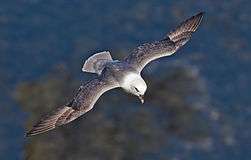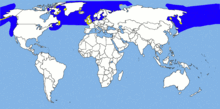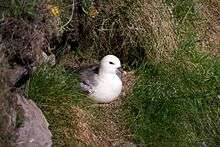Northern fulmar
| Northern fulmar | |
|---|---|
 | |
| Scientific classification | |
| Kingdom: | Animalia |
| Phylum: | Chordata |
| Class: | Aves |
| Order: | Procellariiformes |
| Family: | Procellariidae |
| Genus: | Fulmarus |
| Species: | F. glacialis |
| Binomial name | |
| Fulmaris glacialis (Linnaeus, 1761)[2] | |
| Sub-species | |
|
Fulmarus glacialis glacialis | |
 | |
| Range of F. glacialis Breeding range Wintering range | |
The northern fulmar (Fulmarus glacialis), fulmar,[2] or Arctic fulmar[4] is a highly abundant sea bird found primarily in subarctic regions of the North Atlantic and North Pacific oceans. There has been one confirmed sighting in the Southern Hemisphere, with a single bird seen south of New Zealand.[5] Fulmars come in one of two color morphs: a light one, with white head and body and gray wings and tail, and a dark one which is uniformly gray. Though similar in appearance to gulls, fulmars are in fact members of the Procellariidae family, which include petrels and shearwaters.
The northern fulmar and its sister species, the southern fulmar (Fulmarus glacialodes), are the extant members of the genus Fulmarus. The fulmars are in turn a member of the order Procellariiformes, and they all share certain identifying features. First, they have nasal passages that attach to the upper bill called naricorns; however, nostrils on albatrosses are on the sides of the bill, as opposed to the rest of the order, including fulmars, which have nostrils on top of the upper bill. The bills of Procellariiformes are also unique in that they are split into between seven and nine horny plates. One of these plates makes up the hooked portion of the upper bill, called the maxillary unguis. They produce a stomach oil made up of wax esters and triglycerides that is stored in the proventriculus. This can be sprayed out of their mouths as a defense against predators from a very early age, and as an energy rich food source for chicks and for the adults during their long flights.[6] It will mat the plumage of avian predators, and can lead to their death.[7] Finally, they also have a salt gland that is situated above the nasal passage that helps desalinate their bodies, due to the high amount of ocean water that they imbibe. This gland excretes a high saline solution from their nose.[7]
The northern fulmar was first described as Fulmarus glacialis by Carl Linnaeus, in 1761, based on a specimen from within the Arctic Circle, on Spitsbergen.[4]
Subspecies
The northern fulmar consists of three sub-species:[8]
- F. g. glacialis – (Linnaeus, 1761): the nominate race, which breeds in the high Arctic regions of the North Atlantic
- F. g. auduboni – Bonaparte, 1857: breeds in the low Arctic and boreal regions of the North Atlantic
- F. g. rodgersii – Cassin, 1862: breeds on the coast of eastern Siberia and the Alaskan Peninsula
Etymology
Fulmarus glacialis can be broken down to the Old Norse word full meaning "foul" and mar meaning "gull". "Foul-gull" is in reference to its stomach oil and also its superficial similarity to seagulls. Finally, glacialis is Latin for "glacial" because of its extreme northern range.[9]
Description
The northern fulmar has a wingspan of 102 to 112 cm (40–44 in)[4] and is 46 cm (18 in) in length.[10][11][12] Body mass can range from 450 to 1,000 g (16 to 35 oz).[13] This species is gray and white with a pale yellow, thick, bill and bluish legs;[14] however there is both a light morph and dark, or 'blue' morph. In the Pacific Ocean there is an intermediate morph as well. All morphs have certain similarities, such as only the dark morph has more than dark edges on the underneath, and they all have pale inner primaries on the top of the wings. The Pacific morph has a darker tail than the Atlantic morph.[4][10][11][14][15][16][17]
Like other petrels, their walking ability is limited, but they are strong fliers, with a stiff wing action quite unlike the gulls. They look bull-necked compared to gulls, and have short stubby bills.[14] They are long-lived, with a lifespan of 31 years not uncommon.[18]
| Location | Breeding population | Winter population | Breeding trend |
|---|---|---|---|
| Faroe Islands | 600,000 pairs | 500,000–3,000,000 individuals | stable |
| Greenland | 120,000–200,000 pairs | 10,000–100,000 individuals | stable |
| France | 1,300–1,350 pairs | 100–500 individuals | increasing |
| Germany | 102 pairs | increasing | |
| Iceland | 1,000,000–2,000,000 pairs | 1,000,000—5,000,000 individuals | decreasing |
| Ireland | 33,000 pairs | increasing | |
| Denmark | 2 pair | 200–300 individuals | increasing |
| Norway | 7,000–8,000 pairs | increasing | |
| Svalbard | 500,000–1,000,000 pairs | increasing | |
| Russia (Europe) | 1,000–2,500 pairs | ||
| United Kingdom | 506,000 pairs | ||
| Canada, Russia (Asia), & US | 2,600,000–4,200,000 pairs | ||
| Total (adult individuals) | 15,000,000–30,000,000 | increasing |
Behavior
Feeding
This fulmar will feed on shrimp, fish, squid, plankton, jellyfish, and carrion, as well as refuse.[4][7][15][16] When eating fish, they will dive up to several feet deep to retrieve their prey.[12]
Breeding



The northern fulmar starts breeding at between six and twelve years old. It is monogamous, and forms long term pair bonds. It returns to the same nest site year after year.[7] The breeding season starts in May;[4] however, the female has glands that store sperm to allow weeks to pass between copulation and the laying of the egg.[7] Their nest is a scrape on a grassy ledge or a saucer of vegetation on the ground, lined with softer material. The birds nest in large colonies[4][7][12][15][16] Recently, they have started nesting on rooftops and buildings.[4] Both sexes are involved in the nest building process.[7] A single white egg, 61 mm (2.40 in) in size,[7] is incubated for a period of 50 to 54 days, by both sexes. The altricial chick is brooded for 2 weeks and fully fledges after 70 to 75 days. Again, both sexes are involved.[4][7] During this period, the parents are nocturnal, and will not even be active on well-lit nights.[7]
Social behavior
The mating ritual of this fulmar consists of the female resting on a ledge and the male landing with his bill open and his head back. He commences to wave his head side to side and up and down while calling.[7]
They make grunting and chuckling sounds while eating and guttural calls during the breeding season.[15][16]
Conservation
The northern fulmar is estimated to have between 15,000,000 and 30,000,000 mature individuals, that occupy an occurrence range of 28,400,000 km2 (11,000,000 sq mi) and their North American population is on the rise, hence it is listed with the IUCN as Least Concern.[19] The range of these species increased greatly last century due to the availability of fish offal from commercial fleets, but may contract because of less food from this source and climatic change.[4] The population increase has been especially notable in the British Isles.[15]
Footnotes
- ↑ BirdLife International (2012). "Fulmaris glacialis". IUCN Red List of Threatened Species. Version 2013.2. International Union for Conservation of Nature. Retrieved 12 March 2014.
- 1 2 BirdLife International 2009b
- ↑ Brands 2008
- 1 2 3 4 5 6 7 8 9 10 Maynard 2003
- ↑ http://blog.tepapa.govt.nz/2016/03/15/a-new-bird-for-new-zealand-northern-fulmar/
- ↑ Double 2003
- 1 2 3 4 5 6 7 8 9 10 11 Ehrlich 1988
- ↑ Clements 2007
- ↑ Gotch 1995
- 1 2 Sibley 2000
- 1 2 Floyd 2008
- 1 2 3 Harrison & Greensmith 1993
- ↑ Strøm 2011
- 1 2 3 Peterson 1961
- 1 2 3 4 5 Bull & Farrand 1993
- 1 2 3 4 Udvarty & Farrand 1994
- ↑ Dunn & Alderfer 2006
- ↑ BirdLife International 2004
- 1 2 BirdLife International 2009a
References
- Aberdeen (2005). Fowlsheugh Ecology. Lumina Press.
- BirdLife International (2004). "Fulmarus glacialis Northern Fulmar" (PDF). Archived from the original (PDF) on 3 January 2009. Retrieved 17 July 2009.
- BirdLife International (2009a). "Northern Fulmar". BirdLife Species Factsheet. Retrieved 17 July 2009.
- BirdLife International (2009b). The BirdLife checklist of the birds of the world, with conservation status and taxonomic sources.
- Brands, Sheila (14 August 2008). "Systema Naturae 2000 / Classification - Fulmarus glacialis". Project: The Taxonomicon. Retrieved 18 July 2009.
- Bull, John; Farrand, John Jr. (June 1993) [1977]. "Open Ocean". In Opper, Jane. The Audubon Society Field Guide to North American Birds. The Audubon Society Field Guide Series. Birds (Eastern Region) (1st ed.). New York, NY: Alfred A. Knopf. p. 314. ISBN 0-394-41405-5.
- Clements, James (2007). The Clements Checklist of the Birds of the World (6th ed.). Ithaca, NY: Cornell University Press. ISBN 978-0-8014-4501-9.
- del Hoyo, Joseph (ed.). Handbook of the Birds of the World. 1. ISBN 84-87334-10-5.
- Double, M.C. (2003). "Procellariiformes (Tubenosed Seabirds)". In Hutchins, Michael; Jackson, Jerome A.; Bock, Walter J.; Olendorf, Donna. Grzimek's Animal Life Encyclopedia. 8 Birds I Tinamous and Ratites to Hoatzins (2nd ed.). Farmington Hills, MI: Gale Group. pp. 107–111. ISBN 0-7876-5784-0.
- Dunn, Jon L.; Alderfer, Jonathan (2006). "Shearwaters, Petrels (Family Procellariidae)". In Levitt, Barbara. National Geographic Field Guide to the Birds of North America (fifth ed.). Washington D.C.: National Geographic Society. p. 82. ISBN 978-1426208287.
- Ehrlich, Paul R.; Dobkin, David, S.; Wheye, Darryl (1988). The Birders Handbook (First ed.). New York, NY: Simon & Schuster. pp. 14, 29–31. ISBN 0-671-65989-8.
- Floyd, Ted (2008). "Tubenoses: Albatrosses, Shearwaters & Petrels, and Storm-petrels". In Hess, Paul; Scott, George. Smithsonian Field Guide to the Birds of North America (First ed.). New York, NY: HarperCollins Publishers. p. 82. ISBN 978-0-06-112040-4.
- Gotch, A.F. (1995) [1979]. "Albatrosses, Fulmars, Shearwaters, and Petrels". Latin Names Explained A Guide to the Scientific Classifications of Reptiles, Birds & Mammals. New York, NY: Facts on File. pp. 191–192. ISBN 0-8160-3377-3.
- Harrison, P. (1983). Seabirds: an Identification Guide. Beckenham, U.K.: Croom Helm. ISBN 0-7470-1410-8.
- Harrison, C.; Greensmith, A. (1993). "Non-passerines". In Bunting, E. Birds of the World. New York, NY: Dorling Kindersley. p. 50. ISBN 1-56458-295-7.
- Maynard, B.J. (2003). "Shearwaters, petrels, and fulmars (Procellariidae)". In Hutchins, Michael; Jackson, Jerome A.; Bock, Walter J.; Olendorf, Donna. Grzimek's Animal Life Encyclopedia. 8 Birds I Tinamous and Ratites to Hoatzins (2nd ed.). Farmington Hills, MI: Gale Group. pp. 123–133. ISBN 0-7876-5784-0.
- Peterson, Roger T. (1961) [1941]. "Shearwaters, Fulmars, Large Petrels: Procellariidae". A Field Guide to Western Birds. Peterson Field Guide. 2 (Second ed.). Boston, MA: Houghton Mifflin. ISBN 0-395-13692-X.
- Sibley, David A. (2000). "Albatrosses, Petrels and Shearwaters Families: Diomedeidae, Procellariidae". The Sibley Guide to Birds (First ed.). New York, NY: Alfred A. Knopf. p. 32. ISBN 0-679-45122-6.
- Strøm, Hallvard (2011). "Northern Fulmar". Norwegian Polar Institute.
- Udvarty, Miklos D.F.; Farrand, John Jr. (1994) [1977]. Locke, Edie, ed. National Audubon Society Field Guide to North American Birds. National Audubon Field Guide Series. Birds (Western Region) (First ed.). New York, NY: Alfred A. Knopf. pp. 358–359. ISBN 0-679-42851-8.
External links
| Wikimedia Commons has media related to Fulmarus glacialis. |
| Wikispecies has information related to: Fulmarus glacialis |
- BirdLife species factsheet for Fulmarus glacialis
- "Fulmarus glacialis". Avibase.

- "Northern fulmar media". Internet Bird Collection.
- Northern fulmar photo gallery at VIREO (Drexel University)
- Audio recordings of Northern fulmar on Xeno-canto.
